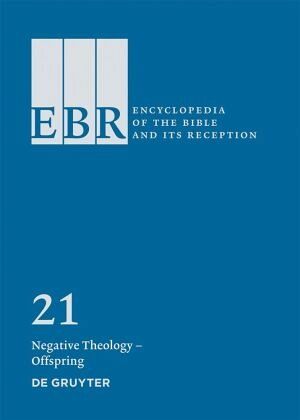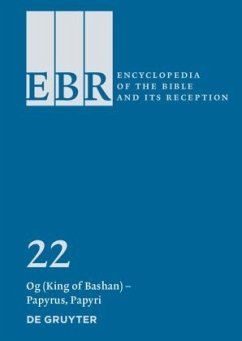Nicht lieferbar

Negative Theology - Offspring / Encyclopedia of the Bible and Its Reception (EBR) Volume 21
Versandkostenfrei!
Nicht lieferbar
The projected thirty-volume Encyclopedia of the Bible and Its Reception (EBR) is intended to serve as a comprehensive guide to the current state of knowledge on the background, origins, and development of the canonical texts of the Bible as they were accepted in Judaism and Christianity. Unprecedented in breadth and scope, this encyclopedia also documents the history of the Bible's interpretation and reception across the centuries, not only in Judaism and Christianity, but also in literature, visual art, music, film, and dance, as well as in Islam and other religious traditions and new religio...
The projected thirty-volume Encyclopedia of the Bible and Its Reception (EBR) is intended to serve as a comprehensive guide to the current state of knowledge on the background, origins, and development of the canonical texts of the Bible as they were accepted in Judaism and Christianity. Unprecedented in breadth and scope, this encyclopedia also documents the history of the Bible's interpretation and reception across the centuries, not only in Judaism and Christianity, but also in literature, visual art, music, film, and dance, as well as in Islam and other religious traditions and new religious movements.
The EBR is also available online.
Blogger's Choice - Articles recommended by biblioblogger Jim West (https://zwingliusredivivus.wordpress.com):
Matthew Page (Loughborough, United Kingdom), Nehemiah (Book and Person) VIII. Film. Nehemiah receives scant treatment in film. Page remarks "Compared to most major biblical stories, filmmakers have largelyoverlooked the book of Nehemiah and its hero." Indeed, as he describes things, the only full-length treatment of Nehemiah is a film produced by the Jehovah's Witnesses. The film, titled Nehemiah: The Joy of Jehovah Is Your Stronghold (prod. Watch Tower Bible and Tract Society, was produced only as recently as 2020. These are the sorts of amazing details that come to light in the EBR. And these details are why EBR is such an incredible, and important resource.
Ada Taggar-Cohen (Kyoto, Japan), Neo-Hittites. "As successors to the Hittite Empire that stretched from central Anatolia into north Syria until 1180 BCE, the people who lived after its collapse in the regions of southeastern Anatolia and northern Syria are known as 'Neo-Hittites.'" Taggar-Cohen then delves into the topics of the history, the cultural evidence, and, this being an Encyclopedia of the Bible and Its Reception, the Neo-Hittites and the Bible. Also included is a very thorough bibliography. This entry is both interesting and well written. A real quality piece of scholarship.
Miryam Brand (Jerusalem, Israel), Nephilim III. Judaism A. Second Temple and Hellenistic Judaism. Brand notes that in texts from the Second Temple period and the Hellenistic era "The Nephilim play a central role in a popular Second Temple era story regarding the origin of evil: the myth of the Watchers." To illustrate the point, she follows her opening declaration with evidence from 1 Enoch, Jubilees, the Dead Sea Scrolls, and Philo. Very much appreciated is her succinct summary of the tales of the Nephilim: "In the fullest form of this story, angels mated with human women and produced giant children who caused destruction, while the angels themselves caused sin by teaching humans illicit knowledge. When the physical bodies of these giants were destroyed, they became evil spirits that plagued the earth."
Jörg Frey (Zurich, Switzerland), Nicodemus I. New Testament. Nicodemus is only named in the Gospel of John. Who he was seems less important than the portrayals foisted on him by the readers of that Gospel. At least that's what Frey seems to suggest when he concludes his entry on Nicodemus in the New Testament with the following lines: "For reading the gospel text, the question of the historical reference of the figure remains of secondary importance. Instead, it is the literary ambivalence of the figure that has stimulated readers up to the present to create their own image of Nicodemus." Nicodemus as Rorschach test. That's the fate of all the characters of the Bible about whom we know so little. What we do know, how
The EBR is also available online.
Blogger's Choice - Articles recommended by biblioblogger Jim West (https://zwingliusredivivus.wordpress.com):
Matthew Page (Loughborough, United Kingdom), Nehemiah (Book and Person) VIII. Film. Nehemiah receives scant treatment in film. Page remarks "Compared to most major biblical stories, filmmakers have largelyoverlooked the book of Nehemiah and its hero." Indeed, as he describes things, the only full-length treatment of Nehemiah is a film produced by the Jehovah's Witnesses. The film, titled Nehemiah: The Joy of Jehovah Is Your Stronghold (prod. Watch Tower Bible and Tract Society, was produced only as recently as 2020. These are the sorts of amazing details that come to light in the EBR. And these details are why EBR is such an incredible, and important resource.
Ada Taggar-Cohen (Kyoto, Japan), Neo-Hittites. "As successors to the Hittite Empire that stretched from central Anatolia into north Syria until 1180 BCE, the people who lived after its collapse in the regions of southeastern Anatolia and northern Syria are known as 'Neo-Hittites.'" Taggar-Cohen then delves into the topics of the history, the cultural evidence, and, this being an Encyclopedia of the Bible and Its Reception, the Neo-Hittites and the Bible. Also included is a very thorough bibliography. This entry is both interesting and well written. A real quality piece of scholarship.
Miryam Brand (Jerusalem, Israel), Nephilim III. Judaism A. Second Temple and Hellenistic Judaism. Brand notes that in texts from the Second Temple period and the Hellenistic era "The Nephilim play a central role in a popular Second Temple era story regarding the origin of evil: the myth of the Watchers." To illustrate the point, she follows her opening declaration with evidence from 1 Enoch, Jubilees, the Dead Sea Scrolls, and Philo. Very much appreciated is her succinct summary of the tales of the Nephilim: "In the fullest form of this story, angels mated with human women and produced giant children who caused destruction, while the angels themselves caused sin by teaching humans illicit knowledge. When the physical bodies of these giants were destroyed, they became evil spirits that plagued the earth."
Jörg Frey (Zurich, Switzerland), Nicodemus I. New Testament. Nicodemus is only named in the Gospel of John. Who he was seems less important than the portrayals foisted on him by the readers of that Gospel. At least that's what Frey seems to suggest when he concludes his entry on Nicodemus in the New Testament with the following lines: "For reading the gospel text, the question of the historical reference of the figure remains of secondary importance. Instead, it is the literary ambivalence of the figure that has stimulated readers up to the present to create their own image of Nicodemus." Nicodemus as Rorschach test. That's the fate of all the characters of the Bible about whom we know so little. What we do know, how




